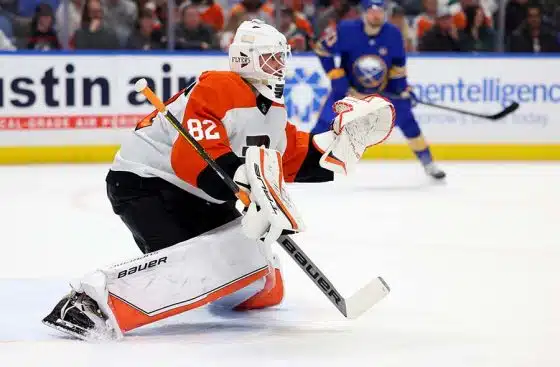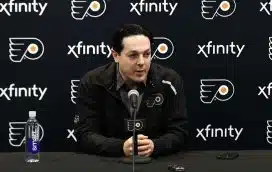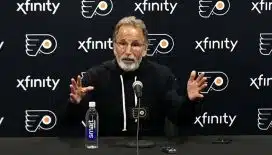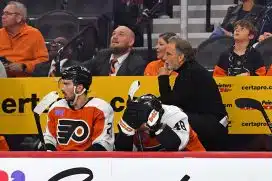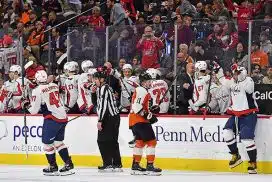By Kevin Durso, Sports Talk Philly editor
During the 2010-11 season, one year removed from the Flyers last appearance in the Stanley Cup Final, Dan Carcillo and Nick Boynton were teammates with the Orange and Black.
Lately, they’ve been teammates of a different kind.
If you follow Carcillo on Twitter, you probably already know of his advocacy toward raising awareness of the dangerous effects of concussions and traumatic brain injuries and his stance on the NHL’s position toward those injuries.
In related pieces on The Players Tribune, Carcillo provided a message by video and Boynton in a written article about their struggles with the effects of traumatic brain injuries. Carcillo, in particular, had urged that the NHL take greater concern for its players and the dangers of these injuries.
“What’s the point of playing professional sports?” Carcillo questions in a video posted to The Players Tribune on Wednesday. “It’s supposed to be for the memories. You can’t remember that anymore. It’s scary.
“I would give back all of my money, all of the time. You can take my name off the Stanley Cup twice over. I can’t live like that anymore.”
Carcillo has gone into detail before about the struggles from dealing with the effects of traumatic brain injuries and details his own treatment in the video, which can be viewed below.
Boynton’s story even has a Flyers connection. Boynton acknowledged that he was a tough player, known more for his mean streak and willingness to fight than producing points. He recounted a moment late in his career in his Players Tribune piece titled “Everything’s Not O.K.” when he seriously felt his life was in jeopardy and credits Paul Holmgren, then the Flyers GM, for essentially saving his life.
“At the tail end of my career, I really, genuinely thought that I was going to die one night during the season. It’s hard to talk about, for sure, but … I had stayed up late doing an obscene amount of coke and things just got out of control. After a while my heart felt like it was going to burst out of my chest. I couldn’t get it to slow down. Nothing I did worked. It was probably the most scared I’ve ever been in my life.
"I was playing for the Flyers at the time, and we had a morning skate I needed to be at in a few hours. So it was either go to the hospital and check in without anyone noticing or getting word about what had gone down, and then somehow get my ass to practice in the morning … or tell the trainer what had happened and try to make a change.”
Boynton told a trainer and that’s when Holmgren stepped in.
“The Flyers and Paul Holmgren, who was the GM in Philly at the time, didn’t judge me or make me feel like an outcast when they found out. They sent me to rehab and pledged their support. They looked out for me. Even though I hadn’t been looking out for myself.
"And to this day, I honestly believe Paul saved my life back then.
"If I had been somewhere else, and they had just traded me away…I’d probably be dead.
"Actually, there’s no doubt about it. I wouldn’t be sitting here today writing this thing if that had happened. That’s for sure.”
Carcillo and Boynton are not the only former Flyers hoping the NHL takes notice at the way concussions and traumatic brain injuries are affecting the game. Hall-of-Famer Eric Lindros, who suffered numerous concussions himself which ultimately shortened his playing career, has also been an advocate.
Bottom line, this is becoming something the NHL can’t continue to ignore. Carcillo’s almost daily reminders of instances occurring in games today are becoming more and more regular and getting more and more circulation.
“The people who are running the NHL and the NHLPA right now need to step up and take care of the best athletes in the world, the best hockey players in the world,” Carcillo said. “Build a brain plasticity center and if an NHL player gets hurt, send him there. You’ll get a better athlete back, you’ll have less man games lost and everybody wins.
“There’s no way an athletic therapist or an orthopedic surgeon should be touching our heads. In my experience, they cannot properly diagnose a traumatic brain injury and they cannot properly build you a program accordingly to make new neurological pathways around those dead neurons. This is how you treat it, this is how it’s diagnosed and this is real treatment.”
This is a discussion that will not go away anytime soon. There are a wave of former players, as well as families from those who watched the effects of these injuries ultimately take the lives of others, that are speaking out and bringing awareness to this issue. With Carcillo leading the charge, that will only continue.

